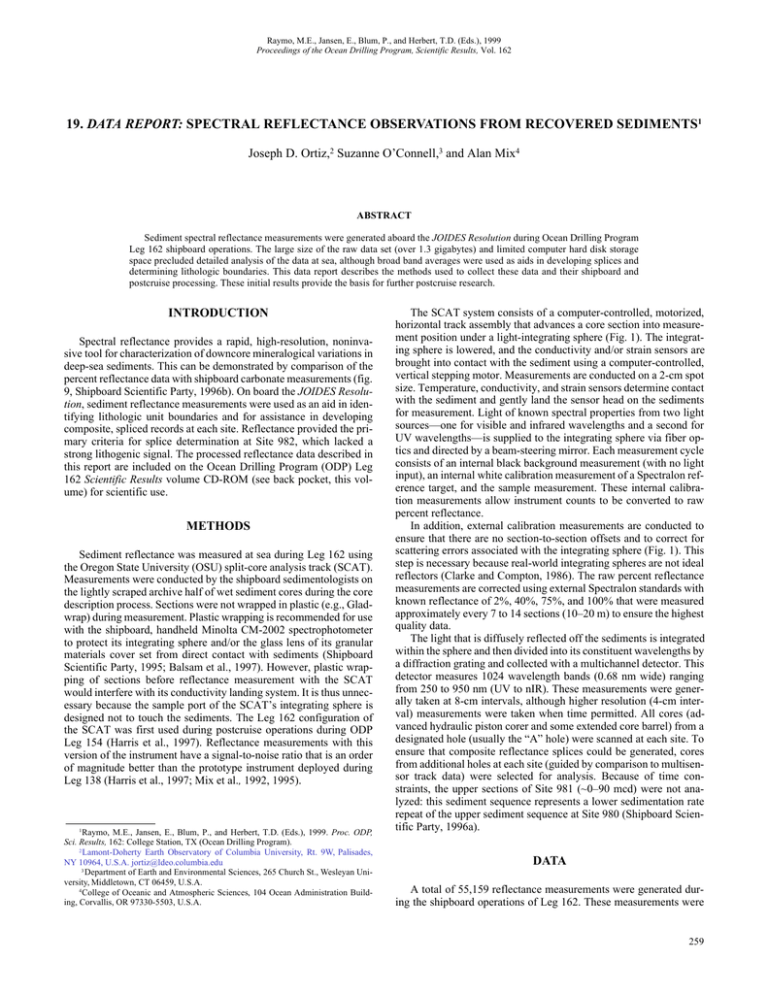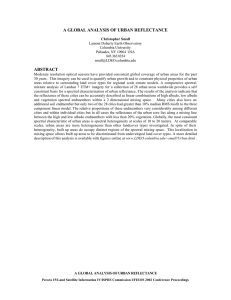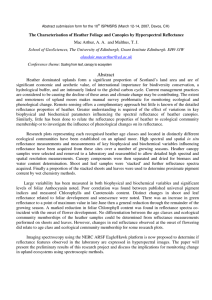DATA REPORT: Joseph D. Ortiz, Suzanne O’Connell,
advertisement

Raymo, M.E., Jansen, E., Blum, P., and Herbert, T.D. (Eds.), 1999 Proceedings of the Ocean Drilling Program, Scientific Results, Vol. 162 19. DATA REPORT: SPECTRAL REFLECTANCE OBSERVATIONS FROM RECOVERED SEDIMENTS1 Joseph D. Ortiz,2 Suzanne O’Connell,3 and Alan Mix4 ABSTRACT Sediment spectral reflectance measurements were generated aboard the JOIDES Resolution during Ocean Drilling Program Leg 162 shipboard operations. The large size of the raw data set (over 1.3 gigabytes) and limited computer hard disk storage space precluded detailed analysis of the data at sea, although broad band averages were used as aids in developing splices and determining lithologic boundaries. This data report describes the methods used to collect these data and their shipboard and postcruise processing. These initial results provide the basis for further postcruise research. INTRODUCTION Spectral reflectance provides a rapid, high-resolution, noninvasive tool for characterization of downcore mineralogical variations in deep-sea sediments. This can be demonstrated by comparison of the percent reflectance data with shipboard carbonate measurements (fig. 9, Shipboard Scientific Party, 1996b). On board the JOIDES Resolution, sediment reflectance measurements were used as an aid in identifying lithologic unit boundaries and for assistance in developing composite, spliced records at each site. Reflectance provided the primary criteria for splice determination at Site 982, which lacked a strong lithogenic signal. The processed reflectance data described in this report are included on the Ocean Drilling Program (ODP) Leg 162 Scientific Results volume CD-ROM (see back pocket, this volume) for scientific use. METHODS Sediment reflectance was measured at sea during Leg 162 using the Oregon State University (OSU) split-core analysis track (SCAT). Measurements were conducted by the shipboard sedimentologists on the lightly scraped archive half of wet sediment cores during the core description process. Sections were not wrapped in plastic (e.g., Gladwrap) during measurement. Plastic wrapping is recommended for use with the shipboard, handheld Minolta CM-2002 spectrophotometer to protect its integrating sphere and/or the glass lens of its granular materials cover set from direct contact with sediments (Shipboard Scientific Party, 1995; Balsam et al., 1997). However, plastic wrapping of sections before reflectance measurement with the SCAT would interfere with its conductivity landing system. It is thus unnecessary because the sample port of the SCAT’s integrating sphere is designed not to touch the sediments. The Leg 162 configuration of the SCAT was first used during postcruise operations during ODP Leg 154 (Harris et al., 1997). Reflectance measurements with this version of the instrument have a signal-to-noise ratio that is an order of magnitude better than the prototype instrument deployed during Leg 138 (Harris et al., 1997; Mix et al., 1992, 1995). 1 Raymo, M.E., Jansen, E., Blum, P., and Herbert, T.D. (Eds.), 1999. Proc. ODP, Sci. Results, 162: College Station, TX (Ocean Drilling Program). 2 Lamont-Doherty Earth Observatory of Columbia University, Rt. 9W, Palisades, NY 10964, U.S.A. jortiz@ldeo.columbia.edu 3 Department of Earth and Environmental Sciences, 265 Church St., Wesleyan University, Middletown, CT 06459, U.S.A. 4 College of Oceanic and Atmospheric Sciences, 104 Ocean Administration Building, Corvallis, OR 97330-5503, U.S.A. The SCAT system consists of a computer-controlled, motorized, horizontal track assembly that advances a core section into measurement position under a light-integrating sphere (Fig. 1). The integrating sphere is lowered, and the conductivity and/or strain sensors are brought into contact with the sediment using a computer-controlled, vertical stepping motor. Measurements are conducted on a 2-cm spot size. Temperature, conductivity, and strain sensors determine contact with the sediment and gently land the sensor head on the sediments for measurement. Light of known spectral properties from two light sources—one for visible and infrared wavelengths and a second for UV wavelengths—is supplied to the integrating sphere via fiber optics and directed by a beam-steering mirror. Each measurement cycle consists of an internal black background measurement (with no light input), an internal white calibration measurement of a Spectralon reference target, and the sample measurement. These internal calibration measurements allow instrument counts to be converted to raw percent reflectance. In addition, external calibration measurements are conducted to ensure that there are no section-to-section offsets and to correct for scattering errors associated with the integrating sphere (Fig. 1). This step is necessary because real-world integrating spheres are not ideal reflectors (Clarke and Compton, 1986). The raw percent reflectance measurements are corrected using external Spectralon standards with known reflectance of 2%, 40%, 75%, and 100% that were measured approximately every 7 to 14 sections (10–20 m) to ensure the highest quality data. The light that is diffusely reflected off the sediments is integrated within the sphere and then divided into its constituent wavelengths by a diffraction grating and collected with a multichannel detector. This detector measures 1024 wavelength bands (0.68 nm wide) ranging from 250 to 950 nm (UV to nIR). These measurements were generally taken at 8-cm intervals, although higher resolution (4-cm interval) measurements were taken when time permitted. All cores (advanced hydraulic piston corer and some extended core barrel) from a designated hole (usually the “A” hole) were scanned at each site. To ensure that composite reflectance splices could be generated, cores from additional holes at each site (guided by comparison to multisensor track data) were selected for analysis. Because of time constraints, the upper sections of Site 981 (~0–90 mcd) were not analyzed: this sediment sequence represents a lower sedimentation rate repeat of the upper sediment sequence at Site 980 (Shipboard Scientific Party, 1996a). DATA A total of 55,159 reflectance measurements were generated during the shipboard operations of Leg 162. These measurements were 259 DATA REPORT Visible-IR Light Source UV Light Source 2x 650MB disks, 5GB tape SUN Ethernet Connection Fiber Optics To Sample Port Beam Steerer Integrating Sphere PC Focusing Mirrors To Reference Port Spectroradiometer Cooled CCD Array Entrance Slit To Detector Diffraction Grating Lander Core Section Figure 1. A schematic illustrating the various components of the OSU SCAT system. (Drawing not to scale.) produced for one or more holes at all of the sites that were drilled during this leg. Summary statistics of these data are provided in Table 1. Processed data from all of these sites are available in a number of forms. For shipboard analysis, percent reflectance was averaged into four 50-nm-wide bands defined as UV (250–300 nm), blue (450–500 nm), red (650–700 nm), and nIR (900–950 nm). These data can be found in the TABLE_2 directory on the volume CD-ROM (back pocket, this volume). During shipboard operations, blue band percent reflectance values were compared with the closest available carbonate measurements to determine if there was a consistent relationship between sediment carbonate content and reflectance (Fig. 2). Postcruise analysis consisted in part of quality control to assure that there were no measurement offsets and of averaging the highresolution data into a 10-nm resolution percent reflectance data set. These data can be found in the TABLE_3 directory on the volume CD-ROM (back pocket, this volume). The 10-nm resolution data were used in conjunction with shipboard percent CaCO3 data to develop proxy percent CaCO3 records. Examples of downcore reflectance variations at the 10-nm wavelength band centered on 665 nm for Sites 980_984 are plotted in Figure 3. This band is selected for illustration because it is close to the maximum output response of the instrument. The first derivative of the reflectance spectra (i.e., its “spectral shape”) is useful for assessment of sediment mineralogy (Balsam and Deaton, 1991; Deaton and Balsam, 1991). The 10-nm resolution data were used to calculate center-weighted, first-derivative spectra (see the TABLE_4 directory on the volume CD-ROM [back pocket, this volume]). We use centered-weighted first derivatives (calculated based on data from above and below the central wavelength) rather than simple first-difference derivatives (calculated between two reflectance measurements) because they are numerically more stable (Press et al., 1992). Examples of downcore variations of the first derivative at 565 nm for Sites 980–984 are plotted in Figure 4. Increases in the first derivative at this wavelength are related to increases in sediment hematite concentration (Deaton and Balsam, 1991). The average reflectance spectra for Sites 980–984 (Fig. 5) exhibit peaks for 260 Core Track Table 1. Statistics on the reflectance observations collected during Leg 162. Hole 162980A 980B 980C 981A 981B 981C 982A 982B 982C 982D 983A 983B 983C 984A 984B 984C 984D 907B 907C 985A 985B 986A 986B 986C 987A 987B 987C 987D Mean percent red reflectance (600–650 nm) S.D. percent red reflectance (600–650 nm) Number of observations 20.23 20.25 17.63 35.33 30.98 31.91 54.41 56.44 55.11 29.80 8.39 7.65 7.58 7.34 6.51 6.51 7.60 9.37 8.41 9.78 10.80 7.60 10.54 7.54 8.75 8.95 10.66 8.54 9.59 9.78 9.26 10.51 8.63 9.74 14.36 13.39 15.64 12.90 2.77 2.93 2.74 2.09 2.29 2.27 2.42 3.94 2.54 3.07 3.80 2.06 2.41 2.00 1.98 2.64 2.98 1.98 2087 1526 1221 2997 878 688 2044 3526 1160 57 3128 3402 3242 1822 3459 3191 170 3217 3093 3292 1567 1631 168 1707 1930 755 516 2450 Note: S.D. = standard deviation. smectite, chlorite, hematite, and a broad absorption band. The latter is associated with organic carbon absorption based on comparison with the factors described in Deaton and Balsam (1991). For ease of comparison, the reflectance data in Figures 3 and 4 have been plotted vs. age (Ma), based on biostratigraphic and magnetostratigraphic age constraints determined during Leg 162. With the DATA REPORT 5. Sites 983 and 984 exhibit much lower amplitude first-derivative variations at 565 nm than Sites 980/981 and 982. 100 90 Bulk CaCO3 (%) 80 ACKNOWLEDGMENTS 70 We thank the captain and crew of the JOIDES Resolution and the co-chief scientists, M. Raymo and E. Jansen, for their assistance at sea. Sara Harris at Oregon State University has been an active collaborator. We also thank William Rugh, who provided much-needed assistance setting up the SCAT system on the JOIDES Resolution. This research was supported in part by a postcruise JOI/USSSP grant to JDO. This data report is LDEO contribution 5791. 60 50 40 Hole 980A Hole 981A Hole 982B Hole 983A Hole 984B 30 20 REFERENCES 10 0 0 10 20 30 40 50 60 70 80 Blue band reflectance (%), 450-500 nm Figure 2. Spectral reflectance (450–500 nm) in relation to the bulk calcium carbonate content of sediments recovered from Leg 162, Sites 980 through 984. Open circles = Hole 980A, open diamonds = Hole 981A, stars = Hole 982B, open squares = Hole 983A, × symbols = Hole 984B. (Fig. 9, Shipboard Scientific Party, 1996b.) exception of the age model for Site 980, these age models are presented in the sedimentation rate sections of the Leg 162 Initial Reports volume (Jansen, Raymo, Blum, et al., 1996). To match the records for Sites 980 and 981 between 1.5 and 1.7 Ma, we visually correlated the Site 980 record with that of Site 981, which has better age control for this time interval (Table 5). The Site 981 age model used here employs the deeper pick (179.48 mcd) for the Matuyama/Gauss boundary (Shipboard Scientific Party, 1996a). SUMMARY OF RESULTS Focusing on the North Atlantic drift sites during the past 2.5 m.y., the reflectance measurements yield consistent patterns from site to site that can be described as follows: 1. Percent reflectance at Sites 980 through 984 demonstrate a systematic relationship to sediment bulk calcium carbonate content (Fig. 2). Higher sediment reflectance (“brightness”) is associated with greater sediment bulk calcium carbonate content. 2. Sediments in the east (Sites 980/981 and 982) exhibit greater mean reflectance values and greater variations in percent reflectance than sediments from the west (Sites 983 and 984) (Table 1; Fig. 3). 3. Sediments older than 2.5 Ma exhibit systematically higher percent reflectance and lower variability than sediments younger than 2.5 Ma (Fig. 3). 4. At Sites 980/981 and 982, the first derivative of the reflectance spectra at 565 nm has low amplitude in sediments older than 2.5 Ma. The mean first derivative value at 565 nm at these sites increases with decreasing age. Balsam, W.L., Damuth, J.E., and Schneider, R.R., 1997. Comparison of shipboard vs. shore-based spectral data from Amazon-fan cores: implications for interpreting sediment composition. In Flood, R.D., Piper, D.J.W., Klaus, A., and Peterson, L.C. (Eds.), Proc. ODP, Sci. Results, 155: College Station, TX (Ocean Drilling Program), 193–215. Balsam, W.L., and Deaton, B.C., 1991. Sediment dispersal in the Atlantic Ocean: evaluation by visible light spectra. Rev. Aquat. Sci., 4:411–447. Clarke, F.J.J., and Compton, J.A., 1986. Correction methods for integratingsphere measurement of hemispherical reflectance, Color Res. Appl., 11:253–262. Deaton, B.C., and Balsam, W.L., 1991. Visible spectroscopy: a rapid method for determining hematite and goethite concentrations in geological materials. J. Sediment. Petrol., 61:628–632. Harris, S.E., Mix, A.C., and King, T., 1997. Biogenic and terrigenous sedimentation at Ceara Rise, western tropical Atlantic, supports Pliocene– Pleistocene deep-water linkage between hemispheres. In Shackleton, N.J., Curry, W.B., Richter, C., and Bralower, T.J., Proc. ODP, Sci. Results, 154: College Station, TX (Ocean Drilling Program), 331–345. Jansen, E., Raymo, M.E., Blum, P., et al., 1996. Proc. ODP, Init. Repts., 162: College Station, TX (Ocean Drilling Program). Mix, A.C., Harris, S.E., and Janecek, T.R., 1995. Estimating lithology from nonintrusive reflectance spectra: Leg 138. In Pisias, N.G., Mayer, L.A., Janecek, T.R., Palmer-Julson, A., and van Andel, T.H. (Eds.), Proc. ODP, Sci. Results, 138: College Station, TX (Ocean Drilling Program), 413– 427. Mix, A.C., Rugh, W., Pisias, N.G., Veirs, S., Leg 138 Shipboard Sedimentologists (Hagelberg, T., Hovan, S., Kemp, A., Leinen, M., Levitan, M., Ravelo, C.), and Leg 138 Scientific Party, 1992. Color reflectance spectroscopy: a tool for rapid characterization of deep-sea sediments. In Mayer, L., Pisias, N., Janecek, T., et al., Proc. ODP, Init. Repts., 138 (Pt. 1): College Station, TX (Ocean Drilling Program), 67–77. Press, W.H., Teukolsky, S.A., Vetterling, W.T., and Flannery, B.P., 1992. Numerical Recipes in Fortran: the Art of Scientific Computing, (2nd ed.): New York (Cambridge Press), 180–184. Shipboard Scientific Party, 1995. Explanatory notes. In Curry, W.B., Shackleton, N.J., Richter, C., et al., Proc. ODP, Init. Repts., 154: College Station, TX (Ocean Drilling Program), 11–38. Shipboard Scientific Party, 1996a. Sites 980/981. In Jansen, E., Raymo, M.E., Blum, P., et al., Proc. ODP, Init. Repts., 162: College Station, TX (Ocean Drilling Program), 49–90. Shipboard Scientific Party, 1996b. Site 984. In Jansen, E., Raymo, M.E., Blum, P., et al., Proc. ODP, Init. Repts., 162: College Station, TX (Ocean Drilling Program), 169–222. Date of initial receipt: 25 August 1997 Date of acceptance: 11 June 1998 Ms 162SR-029 261 DATA REPORT Sites 980/981 Reflectance Band 42: 665 nm Reflectance (%) 80 60 40 20 0 0 0.5 Site 982 Reflectance Band 42: 665 nm 1 0 0.5 Site 983 Reflectance Band 42: 665 nm 1 0 0.5 Site 984 Reflectance Band 42: 665 nm 1 0 1 1.5 2 2.5 1.5 2 2.5 1.5 2 2.5 1.5 2 2.5 Age in Ma Reflectance (%) 80 60 40 20 0 Age in Ma Reflectance (%) 25 20 15 10 5 0 Age in Ma Reflectance (%) 25 20 15 10 5 0 0.5 Age in Ma Figure 3. Downcore variations in diffuse spectral reflectance at 665 nm plotted against age (Ma) based on the shipboard age model for Sites 980 through 984. 262 DATA REPORT δR/δλ at 565 nm 0.2 0.15 0.1 0.05 0 δR/δλ at 565 nm 0.2 δR/δλ at 565 nm 0 0.5 1 Site 982 reflectance 1st derivative (δR/δλ) band 31: 565 nm 1.5 2 2.5 0 0.5 1 Site 983 reflectance 1st derivative (δR/δλ) band 31: 565 nm 1.5 2 2.5 0 0.5 1 Site 984 reflectance 1st derivative (δR/δλ) band 31: 565 nm 1.5 2 2.5 1.5 2 2.5 0.15 0.1 0.05 0 0.1 0.05 0 0.1 δR/δλ at 565 nm Sites 980/981 reflectance 1st derivative (δR/δλ) band 31: 565 nm 0.05 0 0 0.5 1 Age in Ma Figure 4. Downcore variations in the first derivative of diffuse spectral reflectance at 565 nm plotted against age (Ma) based on the shipboard age model for Sites 980 through 984. 263 DATA REPORT 0.15 0.1 Chlorite? Average 1st derivative (δR/δλ) Hematite 0.05 0 -0.05 Figure 5. Average first-derivative spectra for Sites 980–984. Spectral peaks associated with various sediment components are identified based on comparison with the first-derivative factors of Balsam and Deaton (1991). Open circles = Site 980, open diamonds = Site 981, stars = Site 982, open squares = Site 983, × symbols = Site 984. Corg? Site 980 Site 981 Site 982 Site 983 Site 984 -0.1 Smectite? 300 400 500 600 Wavelength λ (nm) Table 5. Age model for Site 980. Event Core top FAD E. huxleyi (N) LAD P. lacunosa (N) Brunhes/Matuyama boundary Jaramillo top Jaramillo bottom LAD Gephyrocapsa A/B (N) Tie to 981 Tie to 981 Tie to 981 Tie to 981 Tie to 981 Tie to 981 Tie to 981 Tie to 981 Base of reflectance record Depth (mcd) Age (Ma) 0.00 35.27 62.82 87.35 100.35 103.72 111.46 125.88 127.75 128.37 129.95 130.51 131.15 131.29 132.49 135.00 0.000 0.260 0.460 0.780 0.990 1.070 1.230 1.516 1.545 1.570 1.595 1.618 1.630 1.644 1.672 1.730 Note: FAD = first appearance datum, LAD = last appearance datum. 264 700 800 900





